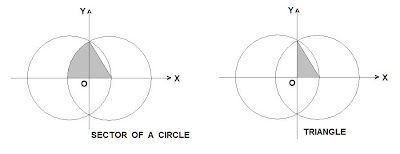Find the common area of two circles of equal radii, R, each passing through the centre of the other.
Answer 254.
Let the circles be drawn in the x-y coordinate plane with their centers at (-R/2, 0) and (R/2, 0) as shown in the figure.
Their equations are
(x + R/2)^2 + y^2 = R^2 ... (1) and
(x - R/2)^2 + Y^2 = R^2 ... (2)
They intersect on the y-axis.
=> Required area
4 times the shaded area
= 4 ∫ (x=0 to R/2) √[R^2 - (x - R/2)^2] dx
= 4 [(x - R/2)/2 * √[R^2 - (x - R/2)^2] + (R^2/2) * arcsin[(x - R/2) / R] ... (x=0 to R/2)
= 4 [ - R/4 * (√3/2) R - (R^2/2) arcsin(-1/2) ]
= (2π/3) R^2 - (√3/2) R^2
= (2π/3 - √3/2) R^2.
Alternate Geometrical Approach:
Join the center of the right-hand circle to the point of intersection of the two circles on +ve y-axis.
Refer to the figure.
Base of the triangle = R/2
Height of the triangle = √[R^2 - (R/2)^2] = (√3/2) R
Area of the gtriangle = (1/2) * (R/2) * (√3/2) R = (1/4) * (√3/2) R^2
Angle subtended by the arc of the circle at gthe center = arccos (R/2) / R = π/6
=> area of the sector of the circle = (π/6) R^2
Required area
= 4 * Shaded area
= 4 * [area of the sector of the circle - area of the right triangle.]
= 4 * [(π/6) R^2 - (1/4) * (√3/2) R^2]
= (2π/3 - √3/2) R^2.
Link to YA!





Sir, thank you so much for your initiative of free material. I have greatly benefited from your notes. May God bless you.
ReplyDelete